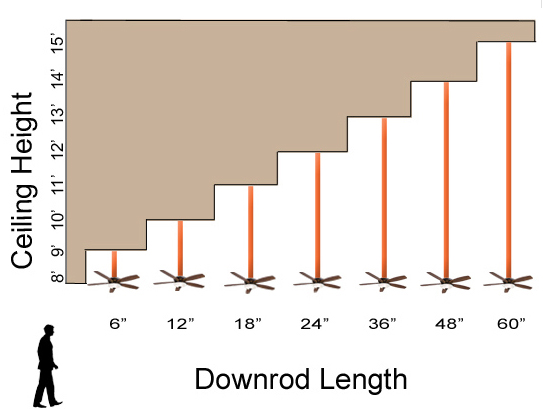How to choose a ceiling fan

With all the choices out there, how do you choose a ceiling fan? What is it important to look for?
The best ceiling fans are made of high quality materials and have strong precision motors that can move some air without noise and wobbles.
So, How do you determine which fan is better than the other?
Here are five things to look when choosing a ceiling fan:
CFM Motor sizeBlade pitchBlade size Ceiling Height
CMF. The airflow of a ceiling fan is measured in CFM (Cubic Feet per Minute) More is Better. It is more important to buy a fan with higher CFMs than it is to buy a fan that uses less electricity, since it moves more air and cools you down more, allowing you to set the thermostat higher. For average size rooms, we like to see ceiling fans that move at least 6000 CFM. Larger rooms need more (or multiple fans.) Smaller rooms can get away with less airflow.
Motor Size Choosing a high-quality motor will eliminate the noise, wobbling, and shaking found in lower-end ceiling fans.Motor sizes are identified by the diameter and the height of the motor. The measurements range from 153 x 10 millimeters up to 212 x 25mm. Bigger is better.
Blade Pitch Cheap fans generally have fan blades that have a low pitch, since the motor can't handle more. A higher blade pitch (13 - 15) degrees will usually move more air, but the pitch of the blade and the power of the motor must fit together so the motor won't burn out or the fan won't be wobbly or noisy. Be careful of judging the quality of the fan based on blade pitch alone. It is all about the ideal combination of motor size and blade pitch.
Blade Size Small Room ( up to 75 sq. ft.) = 36" diameter fan
- Small/Medium Room (76-144 sq. ft.) = 42"-50" diameter fan
- Medium Room (144-225 sq. ft.) = 52"-54" diameter fan
- Large Room (225-400 sq. ft.) = 54"-72" diameter fan
- Great Room (400+ sq. ft.) = more than one 54"-72" diameter fan
Ceiling Height
Ceiling fans are suspended from the ceiling with a pipe that in fan lingo is called a downrod. Choosing the right downrod length is both vital for proper airflow and aesthetic balance. If your fan is positioned too close to the ceiling you don’t get the circulation needed for maximum efficiency and the overall look is crowded. For low ceilings it is recommended to choose a so-called hugger fan that is designed to deal with this situation.
As a rule of thumb, the blades of the ceiling fans should be 8 – 9 feet from the floor for optimal airflow. In higher spaces with an open floor plan, this might look out of proportion. Here a height of 9 – 11 feet to the fan blades might create a more harmonious look. It is, however, important always to keep in mind that a ceiling fan doesn’t cool a room, but creates a pleasant breeze. If the fan is positioned too high and you don’t feel the airflow it is not able to do its job.
For a quick way to determine your downrod length take the height of the ceiling and deduct the height of the ceiling fan body. Then deduct 8 feet.
So, if your ceiling is 10 feet and the description of the ceiling fan is 12” in height, you’ll need a 12” downrod. You can refer to the chart above for more sizes.












